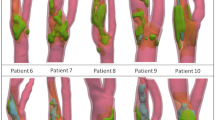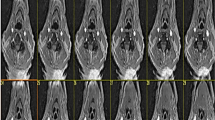Abstract
A 1D model is used to simulate blood flow in major vessels of the upper body and head. The 1D part is stated in terms of viscous incompressible fluid flow in the network of elastic tubes. Two different types of junctions are considered: junctions between major vessels and junctions between arteries and venous pressure. Terminal arteries are connected to the venous pressure through hydraulic resistances. An iterative method is proposed to calculate blood flow velocities and pressures at terminal points. Geometry structure of arteries is obtained from patient-specific data. The reconstruction algorithm consists of vessel segmentation, thinning-based extraction of the set of centerlines, and graph reconstruction. Input data is 3D DICOM datasets, obtained with contrast-enhanced computed tomography angiography. A constructed model is used to study the influence of one or multiple carotid artery stenoses on the blood flow in the circle of Willis. Calculated blood flow velocities were compared to the measured posttreatment ones. The mean relative error was 6%, and the maximum relative error was 20%. The hemodynamic index is proposed based on blood flow velocity in stenosed and collateral arteries. A case of multiple stenoses in vertebral and carotid arteries is investigated. An effect of stenoses locations on cerebral blood flow for two configurations of the circle of Willis is studied.
Access this chapter
Tax calculation will be finalised at checkout
Purchases are for personal use only
Similar content being viewed by others
References
R.W. Hobson, D.G. Weiss, W.S. Fields, J. Goldstone, W.S. Moore, J.B. Towne, C.B. Wright, Efficacy of carotid endarterectomy for asymptomatic carotid stenosis. N. Engl. J. Med. 328, 221–227 (1993)
P. Kopylov, A.A. Bykova, D.Yu. Shchekochikhin, Kh.E. Elmanaa, A.N. Dzyundzya, Yu.V. Vasilevsky, S.S. Simakov, Asymptomatic atherosclerosis of the brachiocephalic arteries: current approaches to diagnosis and treatment. Ter. Arkh. 89(4), 95–100 (2017). https://doi.org/10.17116/terarkh201789495-100
J. Liu, M. Lieb, U. Shah, G.L. Hines, Cerebral hyperperfusion syndrome after carotid intervention: a review. Cardiol. Rev. 20(2), 84–89 (2012)
J. Alastruey, K.H. Parker, J. Peiró, S.M. Byrd, S.J. Sherwin, Modelling the circle of Willis to assess the effects of anatomical variations and occlusions on cerebral flows. J. Biomech. 40(8), 1794–1805 (2007)
G. Zhu, Q. Yuan, J. Yang, J. Yeo, Experimental study of hemodynamics in the circle of Willis. Biomed. Eng. Online 14, S10 (2015)
I. Marshall, S. Zhao, P. Papathanasopoulou, P. Hoskins, Y. Xu, MRI and CFD studies of pulsatile flow in healthy and stenosed carotid bifurcation models. J. Biomech. 37(5), 679–687 (2004)
L.O. Muller, E.F. Toro, A global multiscale mathematical model for the human circulation with emphasis on the venous system. Int. J. Numer. Methods Biomed. Eng. 30(7), 681–725 (2014)
V.B. Koshelev, S.I. Mukhin, T.V. Sokolova, N.V. Sosnin, A.P. Favorski, Mathematical modeling of cardio vascular hemodynamics with account of neuroregulation. Math. Model. 19(3), 15–28 (2007)
A.Y. Bunicheva, M.A. Menyailova, S.I. Mukhin, N.V. Sosnin, A.P. Favorski, Studying the influence of gravitational overloads on the parameters of blood flow in vessels of greater circulation. Math. Models Comput. Simul. 5(1), 81–91 (2013)
J. Alastruey, S.M. Moore, K.H. Parker, T. David, J. Peiro, S.J. Sherwin, Reduced modelling of blood flow in the cerebral circulation: coupling 1-D, 0-D and cerebral auto-regulation models. Int. J. Numer. Methods Fluids 56(8), 1061–1067 (2008)
S.A. Urquiza, P.J. Blanco, M.J. Venere, R.A. Feijoo, Multidimensional modelling for the carotid artery blood flow. Comput. Methods Appl. Mech. Eng. 195(33–36), 4002–4017 (2016). https://doi.org/10.1016/j.cma.2005.07.014
T. Gamilov, R. Pryamonosov, S. Simakov, Modeling of patient-specific cases of atherosclerosis in carotid arteries, in ECCOMAS Congress 2016—Proceedings of the 7th European Congress on Computational Methods in Applied Sciences and Engineering, vol. 1 (2016), pp. 81–89
D.V. Burenchev, P.Y. Kopylov, A.A. Bykova, T.M. Gamilov, D.G. Gognieva, S.S. Simakov, Y.V. Vasilevsky, Mathematical modelling of circulation in extracranial brachocephalic arteries at pre-operation stage in carotid endarterectomy. Russ. J. Cardiol. 4, 88–92 (2017, in Russian)
A. Danilov, Yu. Ivanov, R. Pryamonosov, Yu. Vassilevski, Methods of graph network reconstruction in personalized medicine. Int. J. Numer. Methods Biomed. Eng. 32(8), e02754 (2015). https://doi.org/10.1002/cnm.2754
T.M. Gamilov, P.Y. Kopylov, R.A. Pryamonosov, S.S. Simakov, Virtual fractional flow reserve assessment in patient-specific coronary networks by 1D hemodynamic model. Russ. J. Numer. Anal. Math. Model. 30(5), 269–276 (2015)
S.S. Simakov, T.M. Gamilov, Y.N. Soe, Computational study of blood flow in lower extremities under intense physical load. Russ. J. Numer. Anal. Math. Model. 28(5), 485–504 (2013)
T. Gamilov, P. Kopylov, S. Simakov, Computational simulations of fractional flow reserve variability. Lecture notes in computational science and engineering, vol. 112 (2016), pp. 499–507
Acknowledgements
The authors are thankful to scientists from I.M. Sechenov First Moscow State Medical University, particularly to N. Gagarina, E. Fominykh, and A. Dzyundzya for their data and to R. Pryamonosov for assistance in designing the 1D structure of the patient-specific arterial networks. The research was supported by Russian Science Foundation (grant No. 14-31-00024).
Author information
Authors and Affiliations
Corresponding author
Editor information
Editors and Affiliations
Rights and permissions
Copyright information
© 2018 Springer International Publishing AG, part of Springer Nature
About this chapter
Cite this chapter
Gamilov, T., Simakov, S., Kopylov, P. (2018). Computational Modeling of Multiple Stenoses in Carotid and Vertebral Arteries. In: Mondaini, R. (eds) Trends in Biomathematics: Modeling, Optimization and Computational Problems. Springer, Cham. https://doi.org/10.1007/978-3-319-91092-5_20
Download citation
DOI: https://doi.org/10.1007/978-3-319-91092-5_20
Published:
Publisher Name: Springer, Cham
Print ISBN: 978-3-319-91091-8
Online ISBN: 978-3-319-91092-5
eBook Packages: Mathematics and StatisticsMathematics and Statistics (R0)




